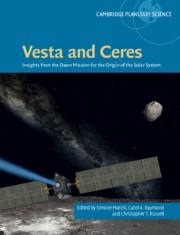Book contents
- Vesta and Ceres: Insights from the Dawn Mission for the Origin of the Solar System
- Cambridge Planetary Science
- Vesta and Ceres
- Copyright page
- Contents
- Contributors
- Preface
- Part I Remote Observations and Exploration of Main Belt Asteroids
- Part II Key Results from Dawn’s Exploration of Vesta and Ceres
- Part III Implications for the Formation and Evolution of the Solar System
- 13 Formation of Main Belt Asteroids
- 14 Isotopic Constraints on the Formation of the Main Belt
- 15 Origin and Dynamical Evolution of the Asteroid Belt
- 16 Collisional Evolution of the Main Belt as Recorded by Vesta
- 17 Epilogue
- Index
- Plate Section (PDF Only)
- References
15 - Origin and Dynamical Evolution of the Asteroid Belt
from Part III - Implications for the Formation and Evolution of the Solar System
Published online by Cambridge University Press: 01 April 2022
- Vesta and Ceres: Insights from the Dawn Mission for the Origin of the Solar System
- Cambridge Planetary Science
- Vesta and Ceres
- Copyright page
- Contents
- Contributors
- Preface
- Part I Remote Observations and Exploration of Main Belt Asteroids
- Part II Key Results from Dawn’s Exploration of Vesta and Ceres
- Part III Implications for the Formation and Evolution of the Solar System
- 13 Formation of Main Belt Asteroids
- 14 Isotopic Constraints on the Formation of the Main Belt
- 15 Origin and Dynamical Evolution of the Asteroid Belt
- 16 Collisional Evolution of the Main Belt as Recorded by Vesta
- 17 Epilogue
- Index
- Plate Section (PDF Only)
- References
Summary
The asteroid belt was dynamically shaped during and after planet formation. Despite representing a broad ring of stable orbits, the belt contains less than one one-thousandth of an Earth mass. The asteroid orbits are dynamically excited, with a wide range in eccentricity and inclination, and their compositions are diverse (generally dry objects in the inner belt and more water-rich objects in the outer belt). The asteroid belt’s origins and dynamical history are reviewed. The classical view is that the belt was born with several Earth masses in planetesimals, then strongly depleted. However, it is possible that very few planetesimals ever formed in the asteroid region and the belt’s story is one of implantation rather than depletion. Many processes may have implanted asteroids from different regions of the Solar System, dynamically removed them, and excited their orbits. During the gaseous disk phase these include the effects of giant planet growth, migration, and sweeping secular resonances. After this phase these include scattering from resident planetary embryos, chaos in the giant planets’ orbits, giant planet instability, and long-term dynamical evolution. Different global models for Solar System formation imply contrasting dynamical histories of the asteroid belt. Vesta and Ceres may have been implanted from opposite regions of the Solar System – Ceres from the Jupiter–Saturn region and Vesta from the terrestrial planet region – and could therefore represent very different formation conditions.
Keywords
- Type
- Chapter
- Information
- Vesta and CeresInsights from the Dawn Mission for the Origin of the Solar System, pp. 227 - 249Publisher: Cambridge University PressPrint publication year: 2022
References
- 10
- Cited by

